DeWalt DW904 Handleiding
Bekijk gratis de handleiding van DeWalt DW904 (6 pagina’s), behorend tot de categorie Zaklamp. Deze gids werd als nuttig beoordeeld door 95 mensen en kreeg gemiddeld 4.3 sterren uit 48 reviews. Heb je een vraag over DeWalt DW904 of wil je andere gebruikers van dit product iets vragen? Stel een vraag
Pagina 1/6

Cordless Worklights
DW902 (9.6V), DW904 (12V), DW906 (14.4V), DW908 (18V)
– Use with DEWALT power packs and chargers (both sold
separately).
IF YOU HAVE ANY QUESTIONS OR COMMENTS ABOUT
THIS OR ANY DEWALT TOOL, CALL US TOLL FREE AT:
1-800-4-DEWALT (1-800-433-9258)
NOTE: Your DW902 worklight operates on a 9.6V power pack. Your
DW904 worklight operates on a 12V battery pack. Your DW906 worklight
operates on a 14.4V power pack. Your DW908 worklight operates on a
18V power pack. Power packs are sold separately.
WARNING: To reduce the risk of injury, read the instruction manual.
General Power Tool Safety Warnings
WARNING! Read all safety warnings and all instructions.
Failure to follow the warnings and instructions may result in electric
shock, fire and/or serious injury.
SAVE ALL WARNINGS AND INSTRUCTIONS
FOR FUTURE REFERENCE
The term “power tool” in the warnings refers to your mains-operated
(corded) power tool or battery-operated (cordless) power tool.
Safety Rules for Worklights
WARNING: DO NOT OPERATE WORKLIGHT OR CHARGER NEAR
FLAMMABLE LIQUIDS OR IN GASEOUS OR EXPLOSIVE ATMOSPHERES.
INTERNAL SPARKS MAY IGNITE FUMES. Do not expose worklight or charger
to rain or damp areas.
WARNING: Lens and bulb become hot during use.
• During or immediately after use, don’t lay worklight flat on lens surface.
• Don’t touch lens surface when bulb is lit or immediately after use.
• Handle worklight with care around any flammable surface.
• If bulb has been lit, let worklight cool for several minutes before changing
bulb.
Important Safety Instructions for All
Battery Chargers
• Before using charger, read all instructions and cautionary markings on
charger, battery pack, and product using battery pack.
DANGER: Electrocution hazard. 120 volts are present at charging terminals.
Do not probe with conductive objects. Electric shock or electrocution may
result.
DANGER: Electrocution hazard. Never attempt to open the battery pack
for any reason. If battery pack case is cracked or damaged, do not insert into
charger. Do not crush, drop or damage battery pack. Do not use a battery pack
or charger that has received a sharp blow, been dropped, run over or damaged
in any way (i.e., pierced with a nail, hit with a hammer, stepped on). Electric
shock or electrocution may result. Damaged battery packs should be returned
to service center for recycling.
• DO NOT attempt to charge the battery pack with any chargers
other than the ones in this manual. The charger and batter y pack are
specifically designed to work together.
• Do not expose charger to rain or snow.
• Pull by plug rather than cord when disconnecting charger. This will
reduce risk of damage to electric plug and cord.
• Make sure that cord is located so that it will not be stepped on,
tripped over, or otherwise subjected to damage or stress.
• Do not use an extension cord unless it is absolutely necessary. Use
of improper extension cord could result in risk of fire, electric shock, or
electrocution.
• Two wire cords can be used with 2 or 3 wire extension cords. Only round
jacketed extension cords should be used, and we recommend that they be
listed by Underwriters Laboratories (U.L.) (C.S.A. in Canada.) The letters WA
on the cord jacket indicate that the cord is suitable for outdoor use.
• An extension cord must have adequate wire size (AWG or American
Wire Gauge) for safety. The smaller the gauge number of the wire, the
greater the capacity of the cable, that is 16 gauge has more capacity than
18 gauge. An undersized cord will cause a drop in line voltage resulting in
loss of power and overheating. When using more than one extension to
make up the total length, be sure each individual extension contains at least
the minimum wire size. The following table shows the correct size to use
depending on cord length and nameplate ampere rating. If in doubt, use the
next heavier gauge. The smaller the gauge number, the heavier the cord.
Recommended Minimum Wire Size for Extension Cords
Total Length of Cord
25 ft. 50 ft. 75 ft. 100 ft. 125 ft. 150 ft. 175 ft.
7.6 m 15.2 m 22.9 m 30.5 m 38.1 m 45.7 m 53.3 m
Wire Size AWG
18 18 16 16 14 14 12
• Do not place any object on top of charger or place the charger on
a soft surface that might block the ventilation slots and result in
excessive internal heat. Place the charger in a position away from any
heat source. The charger is ventilated through slots in the top and the
bottom of the housing.
• Do not operate charger with damaged cord or plug.
• Do not operate charger if it has received a sharp blow, been
dropped, or otherwise damaged in any way. Take it to an authorized
service center.
• Do not disassemble charger; take it to an authorized service center
when service or repair is required. Incorrect reassembly may result in a
risk of electric shock, electrocution or fire.
• Disconnect the charger from the outlet before attempting any
cleaning. This will reduce the risk of electric shock. Removing the
battery pack will not reduce this risk.
• NEVER attempt to connect 2 chargers together.
• Do not store or use the tool and battery pack in locations where
the temperature may reach or exceed 105°F (40˚C) (such as outside
sheds or metal buildings in summer).
• The charger is designed to operate on standard 120V household
electrical power. Do not attempt to use it on any other voltage. This
does not apply to the vehicular charger.
Important Safety Instructions for All
Battery Packs
SPECIFIC SAFETY INSTRUCTIONS FOR NICKEL CADMIUM (NiCd) OR
NICKEL METAL HYDRIDE (NiMH)
• Do not incinerate the battery pack even if it is severely damaged or
is completely worn out. The battery pack can explode in a fire.
• A small leakage of liquid from the battery pack cells may occur
under extreme usage or temperature conditions. This does not
indicate a failure.
However, if the outer seal is broken:
a. and the battery liquid gets on your skin, immediately wash with soap and
water for several minutes.
b. and the battery liquid gets into your eyes, flush them with clean water
for a minimum of 10 minutes and seek immediate medical attention.
(Medical note: The liquid is 25-35% solution of potassium hydroxide.)
SPECIFIC SAFETY INSTRUCTIONS FOR LITHIUM ION (LI-ION)
• Do not incinerate the battery pack even if it is severely damaged
or is completely worn out. The battery pack can explode in a fire. Toxic
fumes and materials are created when lithium ion battery packs are burned.
• If battery contents come into contact with the skin, immediately
wash area with mild soap and water. If battery liquid gets into the eye,
rinse water over the open eye for 15 minutes or until irritation ceases. If
medical attention is needed, the battery electrolyte is composed of a mixture
of liquid organic carbonates and lithium salts.
• Contents of opened battery cells may cause respiratory irritation.
Provide fresh air. If symptoms persists, seek medical attention.
WARNING: Burn hazard. Battery liquid may be flammable if exposed to
spark or flame.
NOTE: Battery storage and carrying caps are provided for use
whenever the battery is out of the tool or charger. Remove cap
before placing battery in charger or tool.
WARNING: Fire hazard. Do not store or carry battery so that metal
objects can contact exposed battery terminals. For example, do not place
battery in aprons, pockets, tool boxes, product kit boxes, drawers, etc., with
loose nails, screws, keys, etc. without battery cap. Transporting batteries
can possibly cause fires if the battery terminals inadvertently come in
contact with conductive materials such as keys, coins, hand tools and
the like. The US Department of Transportation Hazardous Material Regulations
(HMR) actually prohibit transporting batteries in commerce or on airplanes (i.e.,
packed in suitcases and carry-on luggage) UNLESS they are properly protected
from short circuits. So when transporting individual batteries, make sure that

FIG. 1
LENS HOLDER
PORTE-LENTILLE
SUJETADOR DE
LA LENTE
BULB
AMPOULE
BOMBILLA
BATTERY RELEASE BUTTON
BOUTON DE DÉGAGEMENT DE LA PILE
BOTON DE LIBERACION DE LA BATERIA
POWER PACK (NOT
INCLUDED)
ENSEMBLE DE PILES
(NON COMPRIS)
BATERIA (NO INCLUIDA)
SWIVELING HEAD
TÊTE PIVOTANTE
CABEZA GIRATORIA
SWITCH
INTERRUPTEUR
INTERRUPTOR
FIG. 3 SPARE BULB STORAGE
RANGEMENT DE
L’AMPOULE DE RECHANGE
COMPARTIMIENTO
PARA BOMBILLA DE
REPUESTO
FIG. 2
the battery terminals are protected and well insulated from materials that could
contact them and cause a short circuit.
Charging Procedure
DANGER: Electrocution hazard. 120 volts present at charging terminals. Do
not probe with conductive objects. Danger of electric shock or electrocution.
1. Plug the charger into an appropriate outlet before inserting battery pack.
2. Insert the battery pack into the charger. The red (charging) light will blink
continuously indicating that the charging process has started.
3. The completion of charge will be indicated by the red light remaining ON
continuously. The pack is fully charged and may be used at this time or left
in the charger.
DW9115 (15 MINUTE CHARGER) ONLY
1. Plug the charger into an appropriate AC power outlet. The charger will beep
twice and the red light will blink and then go off.
2. Insert the battery pack into the charger, making sure the pack is fully
seated in the charger. The red light will blink and the charger will beep once
indicating the charging process has started.
3. The battery pack will be fully charged in less than 15 minutes under most
conditions. This will be indicated by the red light remaining ON and 3
audible beeps. The pack is fully charged and may be used at this time or
left in the charger.
Installing and Removing the Battery Pack
To insert the power pack into your worklight, slide it into the end of the light until
it snaps into place. To remove the power pack, depress the release buttons
shown and withdraw the power pack.
Switch
To turn the light on, slide the switch forward. To turn it off, slide the switch back.
Swiveling Head (Fig. 1, 2)
Your worklight has a swiveling head. To convert your light to a right angle
model, grasp the front end of the light forward of the switch and hold the back
end firmly. Twist the front end clockwise (as viewed from the lens) until the
head swivels 90 degrees and clicks into place. To return the head to a straight
position, rotate the head (as viewed from the lens) counterclockwise until it
clicks into the straight position.
Replacing the Light Bulb
Worklight Cat. No Replacement Bulb Cat. No.
DW902 DW9023
DW904 DW9043
DW906 DW9063
DW908 DW9083
To replace the light bulb, first unscrew the lens holder. Pull the bulb out of the
spring, and insert a new bulb. Reinstall lens holder.
NOTE: Do not look directly into the worklight beam.
Spare Bulb Storage (Fig. 3)
To store a bulb, unscrew the lens holder and remove it. Inside the body of the
worklight is the storage socket. To remove the bulb, pull it up and out of the
storage area.
NOTE: Removing a pack from the charger and immediately inserting it into the
worklight may weaken bulb life.
The RBRC™ Seal
The RBRC™ (Rechargeable Battery Recycling Corp oration)
Seal on the nickel cadmium, nickel metal hydride or lithium ion
batteries (or battery packs) indicate that the costs to recycle
these batteries (or battery packs) at the end of their useful life
have already been paid by DEWALT. In some areas, it is illegal to place spent
nickel cadmium, nickel metal hydride or lithium ion batteries in the trash or
municipal solid waste stream and the RBRC program provides an environmentally
conscious alternative.
RBRC™ in cooperation with DEWALT and other battery users, has established
programs in the United States and Canada to facilitate the collection of spent
nickel cadmium, nickel metal hydride or lithium ion batteries. Help protect our
environment and conserve natural resources by returning the spent nickel
cadmium and nickel cadmium, nickel metal hydride or lithium ion batteries to
an authorized DEWALT service center or to your local retailer for recycling. You
may also contact your local recycling center for information on where to drop
off the spent battery.
RBRC™ is a registered trademark of the Rechargeable Battery Recycling
Corporation.
Repairs
The charger is not serviceable. There are no serviceable parts inside the
charger.
Lampes de travail
MODÈLES DW902 (9,6 V), DW904 (12 V), DW906 (14,4 V) ET
DW908 (18 V)
– Utiliser avec des ensembles de piles et des chargeurs DEWALT
(vendus séparément).
POUR TOUT RENSEIGNEMENT SUR L’OUTIL OU TOUT AUTRE OUTIL
DEWALT, COMPOSER SANS FRAIS LE:
18004-DEWALT (1800 433-9258)
NOTE: La lampe de travail, modèle DW902, s’alimente à l’aide d’un ensemble
de piles de 9,6 volts. La lampe de travail, modèle DW904, s’alimente à l’aide
d’un ensemble de piles de 12 volts. La lampe de travail, modèle DW906,
s’alimente à l’aide d’un ensemble de piles de 14,4volts. La lampe de travail,
modèle DW908, s’alimente à l’aide d’un ensemble de piles de 18 volts. Les
ensembles de piles sont vendus séparément.
To assure product SAFETY and RELIABILITY, repairs, maintenance and
adjustments (including brush inspection and replacement) should be
performed by a DEWALT factory service center, a D WALT authorized E
service center or other qualified service personnel. Always use identical
replacement parts.
Three Year Limited Warranty
DEWALT will repair, without charge, any defects due to faulty materials or
workmanship for three years from the date of purchase. This warranty does
not cover part failure due to normal wear or tool abuse. For further detail of
warranty coverage and warranty repair information, visit www.dewalt.com
or call 1-800-4-DEWALT (1-800-433-9258). This warranty does not apply to
accessories or damage caused where repairs have been made or attempted
by others. This warranty gives you specific legal rights and you may have other
rights which vary in certain states or provinces.
In addition to the warranty, DEWALT tools are covered by our:
1 YEAR FREE SERVICE
DEWALT will maintain the tool and replace worn parts caused by normal use,
for free, any time during the first year after purchase.
90 DAY MONEY BACK GUARANTEE
If you are not completely satisfied with the performance of your DEWALT
Power Tool, Laser, or Nailer for any reason, you can return it within 90 days
from the date of purchase with a receipt for a full refund – no questions asked.
LATIN AMERICA: This warranty does not apply to products sold in Latin
America. For products sold in Latin America, see country specific warranty
information contained either in the packaging, call the local company or see
website for warranty information.
FREE WARNING LABEL REPLACEMENT: If your warning labels become
illegible or are missing, call 1-800-4-DEWALT for a free replacement.

présente au moins le calibre de fil minimum. Le tableau ci-dessous illustre
les calibres à utiliser selon la longueur de rallonge et l’intensité nominale
indiquée sur la plaque signalétique. En cas de doutes, utiliser le calibre
suivant. Plus le calibre est petit, plus la rallonge peut supporter de courant.
Calibre minimal des cordons de rallonge
Longueur totale du cordon
25 ft. 50 ft. 75 ft. 100 ft. 125 ft. 150 ft. 175 ft.
7,6 m 15,2 m 22,9 m 30,5 m 38,1 m 45,7 m 53,3 m
Intensité AWG
18 18 16 16 14 14 12
• Ne pas mettre d’objet sur le chargeur ni mettre ce dernier sur une
surface molle pouvant obstruer les fentes de ventilation et ainsi
provoquer une chaleur interne excessive. Éloigner le chargeur de toute
source de chaleur. La ventilation du chargeur se fait par les fentes pratiquées
dans les parties supérieures et inférieures du boîtier.
• Ne pas faire fonctionner le chargeur si la fiche ou le codon est
endommagé(e).
• Ne jamais se servir d’un chargeur qui a subi un choc violent, qui
est tombé ou qui est endommagé. Le faire vérifier dans un centre de
réparation autorisé.
• Ne pas démonter le chargeur; l’apporter à un centre de réparation
autorisé lorsqu’un entretien ou une réparation est requise. Le
remontage non conforme du chargeur comporte des risques de choc
électrique, d’électrocution ou d’incendie.
• Débrancher le chargeur avant de le nettoyer. Cela réduira le risque
de choc électrique. Le risque ne sera pas éliminé en enlevant simplement
le bloc-piles.
• NE JAMAIS tenter de relier deux chargeurs ensemble.
• Ne pas ranger ni utiliser l’outil et le bloc-piles à un endroit où la
température peut atteindre ou dépasser les 40 °C (105 °F) (comme
dans les remises extérieures ou les bâtiments métalliques l’été).
• Le chargeur est conçu pour être alimenté en courant domestique
standard de 120 volts. Ne pas utiliser une tension supérieure pour le
chargeur. Cela ne s’applique pas au chargeur pour poste mobile.
Directives de sécurité importantes pour
tous les blocs-piles
DIRECTIVES DE SÉCURITÉ SPÉCIFIQUES AUX PILES DE
NICKEL-CADMIUM (NiCd) OU À L’HYDRURE MÉTALLIQUE
DE NICKEL (NiMH)
• Ne pas incinérer le bloc-piles, même s’il est très endommagé ou
complètement usé, car il pourrait exploser au contact de flammes.
• Une petite fuite de liquide peut se produire dans les cellules du bloc-
piles en cas d’utilisation extrême ou de conditions de température.
Cela n’indique pas de défaillance.
Toutefois, si le joint d’étanchéité extérieur est rompu :
a. et que le liquide entre en contact avec la peau, laver rapidement la zone
touchée au savon et à l’eau pendant plusieurs minutes.
b. si le liquide du bloc-piles entre en contact avec les yeux, les rincer
abondamment à l’eau propre, pendant un minimum de 10 minutes, et
consulter immédiatement un médecin. (Note médicale : le liquide est
composé d’une solution comprenant de 25 % à 35 % d’hydroxyde de
potassium).
DIRECTIVES DE SÉCURITÉ SPÉCIFIQUES POUR LES PILES AU
LITHIUM-ION (LI-ION)
• Ne pas incinérer le bloc-piles, même s’il est très endommagé ou
complètement usé, car il peut exploser au contact de flammes. Des
vapeurs et des matières toxiques sont dégagées lorsque les blocs-piles au
lithium-ion sont incinérés.
• Si le contenu du bloc-piles entre en contact avec la peau, laver
immédiatement la zone touchée au savon doux et à l’eau. Si le liquide
de la pile entre en contact avec les yeux, rincer l’œil ouvert à l’eau pendant
15 minutes ou jusqu’à ce que l’irritation cesse. Si des soins médicaux
sont nécessaires, l’électrolyte du bloc-piles est composé d’un mélange de
carbonates organiques liquides et de sels de lithium.
• Le contenu des cellules de pile ouvertes peut provoquer une
irritation respiratoire. Exposer la personne à de l’air frais. Si les
symptômes persistent, obtenir des soins médicaux.
AVERTISSEMENT : Risque de brûlure. Le liquide du bloc-piles peut
s’enflammer s’il est exposé à des étincelles ou à une flamme.
REMARQUE : un boîtier spécial et des capuchons de sécurité
sont fournis avec le bloc-piles pour utilisation chaque fois qu’on le
retire de l’outil ou du chargeur pour le ranger ou le transporter.
Enlever le capuchon avant de remettre le bloc-piles dans le chargeur
ou l’outil.
AVERTISSEMENT : afin de réduire le risque de blessures, lire le mode
d’emploi de l’outil.
Avertissements de sécurité généraux pour
les outils électriques
AVERTISSEMENT! Lire tous les avertissements de sécurité et
toutes les directives. Le non-respect des avertissements et des
directives pourrait se solder par un choc électrique, un incendie et/ou une
blessure grave.
CONSERVER TOUS LES AVERTISSEMENTS ET TOUTES LES
DIRECTIVES POUR UN USAGE ULTÉRIEUR
Le terme « outil électrique » cité dans les avertissements se rapporte
à votre outil électrique à alimentation sur secteur (avec fil) ou par piles
(sans fil).
Mesures de sécurité relatives aux lampes de
travail
AVERTISSEMENT : NE PAS UTILISER LA LAMPE DE
TRAVAIL NI LE CHARGEUR PRÈS DE LIQUIDES INFLAMMABLES NI
DANS UN ENDROIT RENFERMANT DES VAPEURS INFLAMMABLES OU
EXPLOSIVES. DES ÉTINCELLES DANS CES PRODUITS POURRAIENT
ENFLAMMER LES VAPEURS. Protéger la lampe de travail ou le chargeur de
la pluie et des endroits humides.
AVERTISSEMENT: La lentille et l’ampoule deviennent brûlants pendant
l’utilisation.
• Pendant l’utilisation ou immédiatement après s’être servi de la lampe
de travail , ne pas toucher à la lentille.
• Ne pas toucher à la surface de la lentille une fois l’ampoule allumé ou
immédiatement après qu'il a été éteint.
• Manipuler la lampe de travail avec soin à proximité de toute surface
inflammable.
• Lorsque l’ampoule a fonctionné, laisser refroidir la lampe pendant
plusieurs minutes avant de remplacer l’ampoule.
Directives de sécurité importantes pour
tous les chargeurs de piles
• Avant d’utiliser le chargeur, lire toutes les directives et tous les avertissements
figurant sur le chargeur, le bloc-piles et le produit utilisé avec le bloc-piles.
DANGER : Risque d’électrocution. Les bornes de charge présentent une
tension de 120 volts. Ne pas sonder les bornes avec des objets conducteurs.
En effet, il y a risque de choc électrique ou d’électrocution.
DANGER : Risque d’électrocution. Ne jamais ouvrir le bloc-piles pour
quelque raison que ce soit. Si le boîtier du bloc-piles est fissuré ou endommagé,
ne pas l’insérer dans un chargeur. Ne pas écraser, faire tomber ou endommager
le bloc-piles. Ne pas utiliser un bloc-piles ou un chargeur qui a reçu un choc
violent, qui est tombé, a été écrasé ou est endommagé de quelque manière que
ce soit (p. ex. percé par un clou, frappé d’un coup de marteau, piétiné). En effet,
il y a risque de choc électrique ou d’électrocution. Les blocs-piles endommagés
doivent être envoyés au centre de réparation pour être recyclés.
• NE PAS charger le bloc-piles au moyen de tout autre chargeur
que ceux qui sont mentionnés dans le présent mode d’emploi.
Le chargeur et le bloc-piles sont spécialement conçus pour être utilisés
ensemble.
• Protéger le chargeur de la pluie et de la neige.
• Tirer sur la fiche plutôt que sur le cordon pour débrancher le
chargeur. Cela permet de réduire le risque d’endommager la fiche ou le
cordon d’alimentation.
• S’assurer que le cordon est situé en lieu sûr de manière à ce que
personne ne marche ni ne trébuche dessus ou à ce qu’il ne soit pas
endommagé ni soumis à une tension.
• Ne pas utiliser de rallonge à moins que cela ne soit absolument
nécessaire. L’utilisation d’une rallonge inadéquate risque d’entraîner un
incendie, un choc électrique ou une électrocution.
• Les cordons bifilaires peuvent servir avec des cordons de rallonge bifilaires
ou trifilaires. Il faut seulement utiliser des cordons de rallonge àgaine ronde.
Il est conseillé d’utiliser des cordons homologués par l’organisme UL (CSA
au Canada). Les lettres WA sur le cordon signifient que le cordon est conçu
pour l’extérieur.
• Pour la sécurité de l’utilisateur, utiliser une rallonge de calibre
adéquat (AWG, American Wire Gauge [calibrage américain normalisé
des fils]). Plus le numéro de calibre de fil est petit et plus sa capacité est
grande, par exemple un calibre 16 a plus de capacité qu’un calibre 18.
L’usage d’une rallonge de calibre insuffisant causera une chute de tension
entraînant perte de puissance et surchauffe. Si plus d’une rallonge est
utilisée pour obtenir la longueur totale, s’assurer que chaque rallonge
Product specificaties
| Merk: | DeWalt |
| Categorie: | Zaklamp |
| Model: | DW904 |
Heb je hulp nodig?
Als je hulp nodig hebt met DeWalt DW904 stel dan hieronder een vraag en andere gebruikers zullen je antwoorden
Handleiding Zaklamp DeWalt
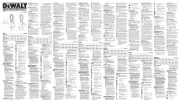
23 Mei 2025

18 Mei 2023

6 Mei 2023

5 Mei 2023

11 April 2023

6 April 2023

31 Maart 2023

8 Maart 2023

4 Maart 2023

27 Februari 2023
Handleiding Zaklamp
- Livarno Lux
- Dorr
- FoxFury
- Nite Ize
- Spanninga
- Beghelli
- Casalux
- Blackburn
- Maglite
- Alpen Optics
- Stanley
- Aluratek
- Powerplus
- TFA
- Celestron
Nieuwste handleidingen voor Zaklamp
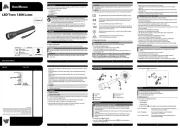
16 Juli 2025
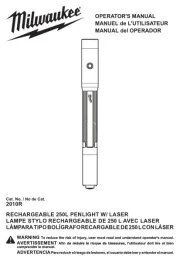
15 Juli 2025
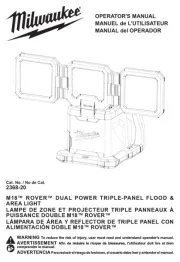
14 Juli 2025
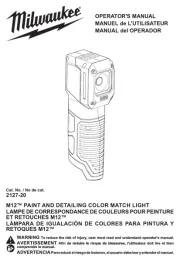
14 Juli 2025
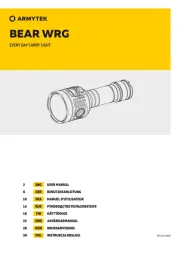
14 Juli 2025
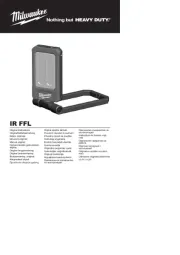
14 Juli 2025
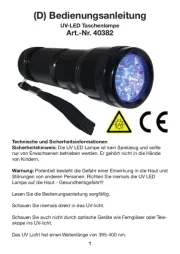
10 Juli 2025
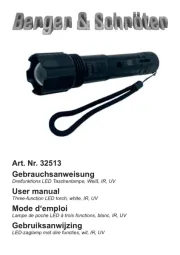
5 Juli 2025
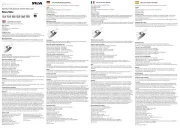
4 Juli 2025
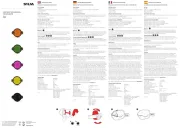
4 Juli 2025